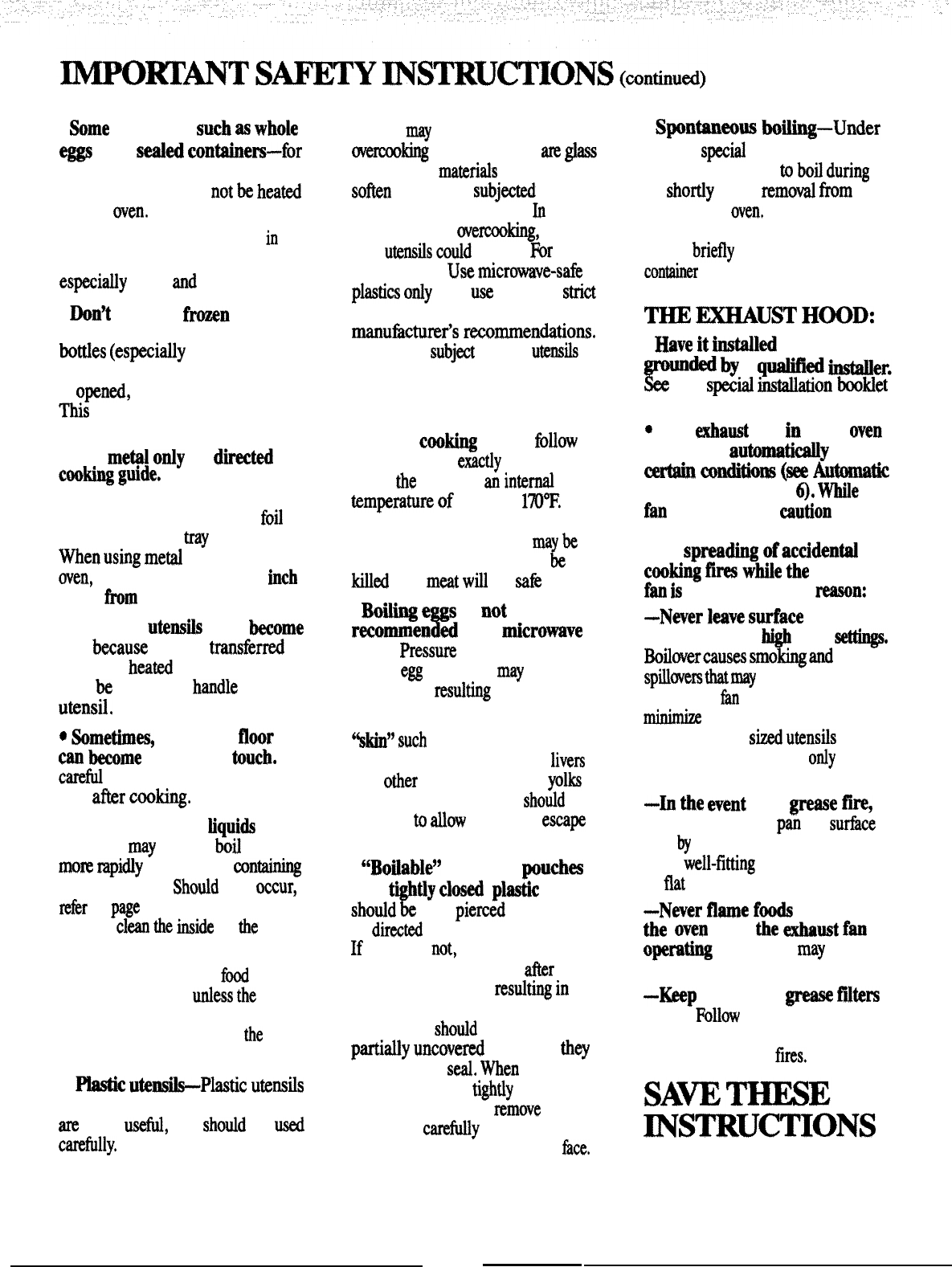
●
Some
products
such
m
whole
eggs
and
ded
contiers-for
example, closed glass jars-may
explode and should
not
be
heated
in this
oven.
●
Avoid
heating baby food
k
glass jars, even without
their lids;
especitiy meat
and
egg mixtures.
.
mn’t
defrost
f-n
beverages
in narrow necked
boties
[es~idy
carbonated
beverages). Even if the container
is
opened,
pressure can buildup.
This
can cause the container to
burst, resulting in injury.
●
Use
metal
o~y
as
direeted
in
CWMW
gtide.
TV dinners may
be
microwaved in foil trays less
than 3/4” high; remove top tifi
cover and return
tray
to box.
men
using
meti
in microwave
oven,
keep metal at least 1
inch
away
hm
sides of oven.
●
Cooking
utensM
may
beeome
hot
bwause
of heat
transfird
from the
heati
food. Potholders
may
be
needed to
handle
the
utensfl.
*
Sornetimesj
the oven
floor
ean
kome
too hot to
touch.
Be
care~
touching the floor
during
and
akr
-king.
●
Foods cooked in
Mquids
(such
as pasta)
may
tend to
bofi
over
mom
mpidy
than foods
mntaining
less moisture.
Shodd
this
wcur,
rekr
to
page
11 for instructions on
how to
clean
the
inside
of
the
oven.
●
Thermometer-~
not
use a thermometer in
fd
you
are microwaving
urdess
the
thermometer is designed or
recommended for use in
the
microwave oven.
*
-
ute-Plastic
Utenstis
designed for microwave cooking
m
very
useM,
but
shodd
be
used
carefu~y,
Even microwave-safe
plastic
may
not be as tolerant of
ovem~
renditions as
@
pass
or ceramic
materitis
and may
soften
or char if
subjwted
to short
periods of overcooking.
h
longer
exposures to
ove~king,
the f@
and
utenstis
cdd
ignite.
%r
these
reasons: 1)
Usemicrowave-safe
pIastics
ody
and
use
them in
stria
compliance with the utensil
manuhcturer’s
rwmrnendations.
2) Do not
subja
empty
utensk
to
microwaving. 3) Do not permit
children to use plastic utensils
without complete supervision.
●
When COO* pork,
fotiow
the directions
exactiy
and always
cook
the
meat to
an
inteti
tempera~re
of
at least
l~°F,
This assures that, in the remote
possibility that trichina
may
be
present in the meat, it will
be
~ed
and
mmt
wtil
be
~
to eat.
●
BoWng
em
is
not
rwommended
in a
dcrowave
oven.
Ressure
can buildup
inside
egg
yolk and
may
cause
it to burst,
resdting
in injury.
●
Foods with unbroken outer
‘%kin”
such
as potatoes, sausages,
tomatoes, apples, chicken
livers
and
other
giblets, and egg
yolks
(see previous caution)
shodd
be
pierced
to
Wow
steam to
esmpe
during cooking.
●
44Eotiable”
cooking
pouA=
and
t~tly
dd
pl~c
bags
shodd
be
slit,
pie~ed
or vented
as
dirwted
in the cooking guide.
If
they are
not,
plastic could burst
during or immediately
aft~r
cooking, possibly
resdting
in
injury. Also, plastic storage
containers
shodd
be at least
ptiidy
uncoved because
they
form a tight
sA.
men
cooking
with containers
tighfly
covered
with plastic wrap,
remove
covering
careMly
and direct
steam away from hands and
tiw.
4
● SPnWOW
boMng-Under
certain
spid
circumstances,
liquids may start
to
boti
during
or
shotiy
after remoti
Wm
the
microwave
oven,
To prevent burns
from splashing liquid, stir the
liquid
briefly
before removing the
mntainer
from the microwave oven.
~
~U~
HWD:
●
Have
it
tiled
and
properly
_
W
a
qmd
-r.
See
the
s~ti
instion
booMet
packed with the microwave oven.
*
The
tiaust
fan
jn
your
oven
*operate automa@y under
*
#nditiona
(see
Automa&
Fan Feature, page
Q.
~le
the
fan
is operating,
mution
is
required to prevent the starting
and
Sp~@
ofmcidenti
cooMng
fires
wMe
the
exhaust
fm
is
in use. For this
-n:
-Never
leawe
surface
units
—
unattended at
~
heat
a.
Bodovercausessmokingand
greasy
sp~overathat~
ignite and spread
if exhaust
tin
is operating. To
~
automatic fan operation,
use adequate
SW
utensfis
and
use high heat settings
ordy
when
necessary.
~h
the
event
of a
grease
fire,
smother flaming
pan
on
sufiee
unit
by
covering pan completely
with
wefl-fitting
lid, cookie sheet
or
flat
tray.
-Never
flame
f~
under
the
OV@~
with
the
tiUSt
fan
operating
because
it
may
spread
the flames.
–@p
hood
and
grease
filters
clean.
PoHow
instructions on
page 28, to maintain good venting
and avoid grease
fires+
mSmUC~ONS


















